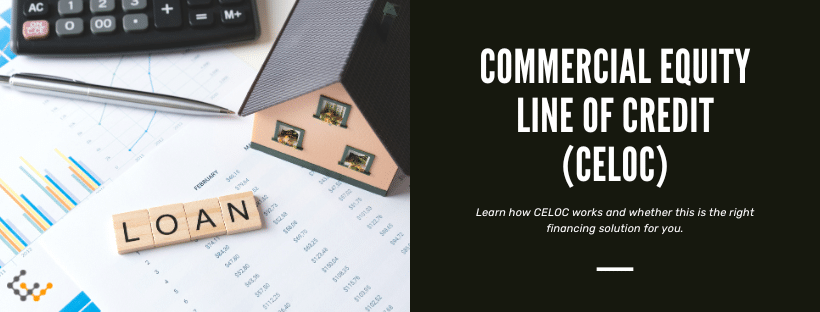What is Commercial Equity Line of Credit (CELOC)?

Commercial real estate investors have access to many different financing programs when they first purchase a property, but sometimes capital’s needed after a property is already owned. A commercial equity line of credit (CELOC) allows investors to use their equity as a means of attaining as-needed financing.
Understanding Commercial Equity Line of Credit (CELOC)
A commercial equity line of credit is a financing option that allows property investors to tap the equity in a property and free up funds. The line of credit allows businesses to borrow, repay, and borrow again as they need to, up to a certain credit limit.
Answer a few questions and get custom mortgage quotes. We'll match you with offers from our network of 650+ lenders.
What is a Commercial Equity Line of Credit (CELOC)?
A commercial equity line of credit is an allowance that businesses can use as they need or want to. The credit is granted by using a property’s equity.
Gaining access to a line of credit is much like using a credit card, and indeed most CELOCs allow investors to access funds via a draw card (akin to a credit card). Because commercial real estate is usually worth a substantial sum, the amount of credit that can be used is typically much higher than what a credit card would allow. Funds can be used for diverse business costs, such as remodeling , equipment purchase, and working capital costs.
A CELOC is also much like a home equity line of credit (HELOC). A CELOC is held against a commercial property rather than a house, though, and therefore may have a much higher credit allowance.
A CELOC is similar to a commercial equity loan, in that both give investors access to capital by drawing against the equity in a commercial real estate property. They differ in how the funds are granted, though. Whereas a CELOC grants access to a line of credit which can be accessed, a commercial equity loan distributes the borrowed amount as a lump sum.
How Does CELOC Work?
A CELOC uses commercial property as collateral. The lender assesses the property and establishes its value. Based on this appraised value and subtracting any outstanding debts on the property, the lender determines a maximum credit limit. The maximum credit allowed is based on the amount of equity in a property and the property’s value.
Property investors/managing partners can then draw from this line of credit as required, with the repaid amount becoming available for future borrowing. An attractive aspect of this arrangement is that interest is payable only on the funds that are actually drawn, making CELOC a flexible and potentially cost-effective option for businesses.
The terms of a basic CELOC might allow for a maximum loan to value of 70-75%, including the CELOC and any other financing. The term is often 5-10 years.
Types of Property Lenders Accept as Collateral for CELOC
Lenders typically accept a diverse range of commercial properties as collateral for CELOC. This could include office buildings, retail spaces, multi-family residential buildings, industrial properties and even unoccupied land.
A line of credit will only be granted if there’s substantial equity in a property, however. Properties also normally must be in at least an acceptable or good condition, and a property’s value comes into play.
Advantages and Disadvantages of CELOC
Like any financial product, a CELOC comes with its own set of advantages and disadvantages. These must be carefully considered when evaluating whether to use this financing option.
CELOC Advantages
- Flexible Funding Source: A CELOC provides a revolving line of credit, allowing businesses to borrow and repay within an established limit. This flexibility can be especially beneficial for managing fluctuating cash flow needs, or preparing for projects that have indeterminate costs.
- Interest on Drawn Amount Only: Unlike traditional loans, businesses only pay interest on the amount they actually draw from the credit line. This potentially saves on interest costs if all of the funds aren’t needed, or if they aren’t all needed at once.
- Use for Various Business Needs: The funds from a CELOC can be used for a wide range of business expenses, from purchasing equipment and renovations to providing working capital or consolidating high-interest debts.
- Lower Interest Rates Than Unsecured: Generally, the interest rates on a CELOC are lower than those of credit cards or unsecured loans, making this a more cost-effective borrowing option.
CELOC Disadvantages
- Risk of Foreclosure: Since a CELOC is secured by commercial property, failure to repay the borrowed amount can lead to foreclosure on the property. For this reason, CELOCs should only be used when there’s a good plan to repay any borrowed funds.
- Variable Interest Rates: The interest rates on a CELOC are typically variable, increasing or decreasing over time based on market conditions. This can make projecting total costs and monthly payments more challenging, especially in a time of changing interest rates.
- Higher Rates Than Traditional Loans: While a CELOC usually offers lower interest rates than credit cards or unsecured loans, the CELOC rates might be higher than those of traditional business loans.
- Associated Costs: CELOCs come with additional costs, beyond interest charged, that must be factored into the overall expense of the credit line (see below).
Costs Associated with CELOC
Though a CELOC can be a convenient funding source, it is not without associated costs. These may include appraisal fees, loan origination fees, annual fees, and potentially even prepayment penalties if the line of credit is cleared before the term concludes.
Moreover, the interest rates on a CELOC are typically variable, meaning they can fluctuate over time in line with market conditions.
Situations Where CELOC May Be Appropriate
A CELOC can be a valuable tool for businesses that have substantial equity in their commercial properties and require flexible financing. This could include businesses seeking to expand, purchase new equipment, fund renovations or manage cash flow.
A less common use is to consolidate high-interest debts, although a commercial equity loan or other more traditional loan tends to be better for this purpose.
For smaller projects and purchases, a business line of credit could also serve as a viable alternative.
Wrapping Things Up
A commercial equity line of credit can offer you flexible and competitive financing. If you or your firm needs funds and has equity in a property, consider whether this is the right financing solution to use.

